Getting to the heart of coast redwood durability
Dean Meason, Mark Riddell, Diahanna O’Callahan, and Armin Thumm, New Zealand Tree Grower August 2018.
Coast redwood has the potential to be a high value timber crop. Its timber has an attractive appearance, high stability and its natural durability make it an ideal timber for outdoor uses. There is strong local and international market for naturally durable timber which does not require chemical preservation or paint for outdoor use. The majority of the international market is supplied from second-growth stands less than 100 years old grown in the United States and which has a reputation for heartwood resistance to decay.
New Zealand is well positioned to fill the demand for redwood products in the US. However, the perception is that New Zealand-grown redwood is inferior to US-grown timber. This is a barrier to selling into the valuable US market.
The current natural durability rating for New Zealand redwood is Class 3 – moderately durable with ground contact and a probable life expectancy of five to 15 years. One of the reasons for this moderate rating is that durability can vary greatly between individual wood samples. Whether this variation is due to genetics, growth rate or some other factor is unclear. Understanding the sources of durability variation will help growers to remove or mitigate these sources by, for example, choosing durable seedlots or clones. This understanding would provide growers and buyers more certainty of heartwood durability at harvest.
The ‘Getting to the heart of coast redwood durability’ Sustainable Farming Fund project was set up in 2015 to quantify the natural durability and variability of redwood heartwood throughout New Zealand. The questions the project wanted to answer included − Do the natural durability characteristics of redwood change between faster growing and slower growing sites? How much do genetics affect natural durability? At what age does heartwood become resistant to decay?
Seeing red
The Scion-based research team believed that near-infrared technology had the potential to be the basis of a rapid and cost-effective method to assess coast redwood heartwood’s resistance to fungal decay. Near-infrared uses light energy from the near-infrared region of the electromagnetic spectrum to interact with chemicals in the heartwood to detect differences. Rather than specifically identifying which chemicals are present, the spectral peaks of heartwood samples which are more and less resistant to fungal decay are compared. The differences in the spectra are used to classify the durability of unknown heartwood samples.
Durability testing
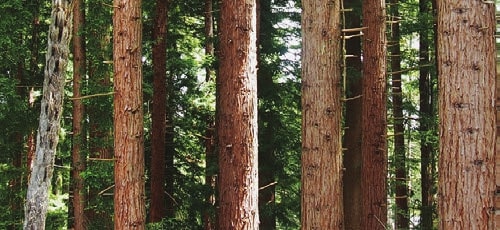
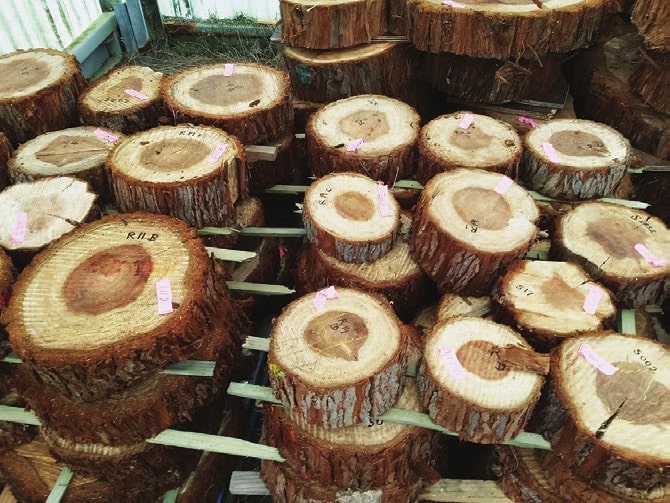
Redwoods from around the country were sampled. In all, 121 trees from eight sites were felled and over 10,000 individual heartwood samples were collected to give a representative sample of trees across a range of genetics, sites and ages. Samples for testing durability via fungal decay testing were prepared from wood discs cut from various heights along the stem. Samples from Californian second-growth forest coast redwood 60 to 100 years old and radiata pine sapwood were used as controls.
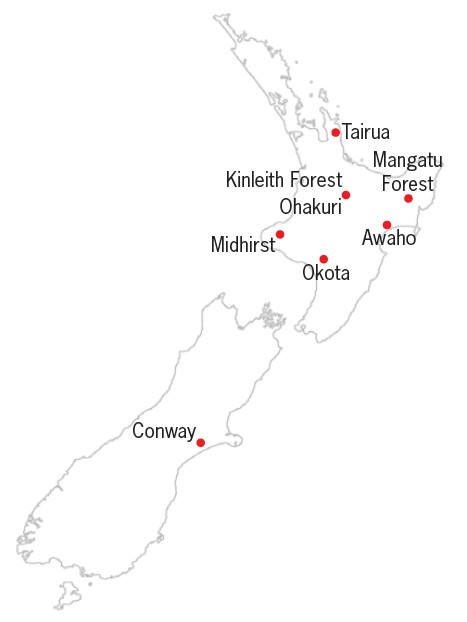
The fungal decay resistance of the coast redwood heartwood blocks and radiata pine sapwood control blocks was evaluated using pure fungal culture decay testing according to European Standards. The fungal cultures used were the brown rots Coniophora puteana and Gloeophyllum trabeum, and the white rot Trametes versicolor.
The fungal cultures were grown in agar for around two weeks. Then the sample blocks of wood were added to the agar containers. Following a 16-week incubation, the samples were weighed to establish how much mass they had lost. Near-infrared spectra were collected from the top faces of samples which had not been exposed to the fungi.
Main results
Heartwood fungal resistance
Coast redwood heartwood was observed to be very resistant to decay from the brown rots. In contrast, the white rot, T. versicolor, was able to attack heartwood more effectively. The white rot also seemed to be more sensitive to the maturity of the heartwood, and the loss of mass caused by this fungus was used to assess the durability of coast redwood.
Effect of age
Heartwood fungal resistance starts at an early age. There was little difference in mass loss between the three oldest sites, suggesting that heartwood reaches maturity, at least for trees less than 90 years old, by 46 years.
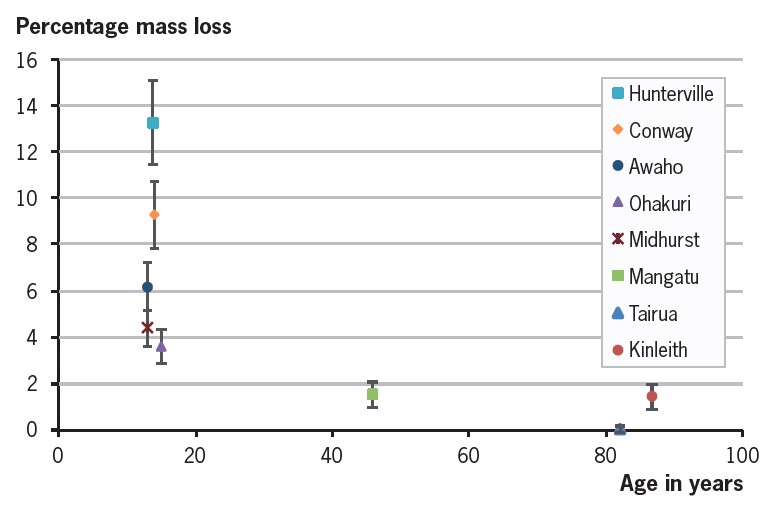
Comparison with Californian second growth redwood
There was no significant difference in heartwood mass loss between samples from Californian second-growth forest coast redwood 60 to 100 years old, and New Zealand grown redwood from Mangatu at 46 years and Kinleith at 87 years. The heartwood from the Tairua site at 82 years was more resistant. This provides evidence that the heartwood of New Zealand grown coast redwood aged greater than 45 years is at least as resistant to fungal decay as the heartwood from Californian second-growth forest.
Effect of genetics
The effect of genetics on heartwood durability was tested on two Kuser provenance trial sites at Awaho and Midhirst, the same clone grown on a low productivity site at Conway and a high productivity site at Okota. The study found that genotype strongly influences heartwood mass loss. The heartwood mass loss for each genotype was consistent across sites.
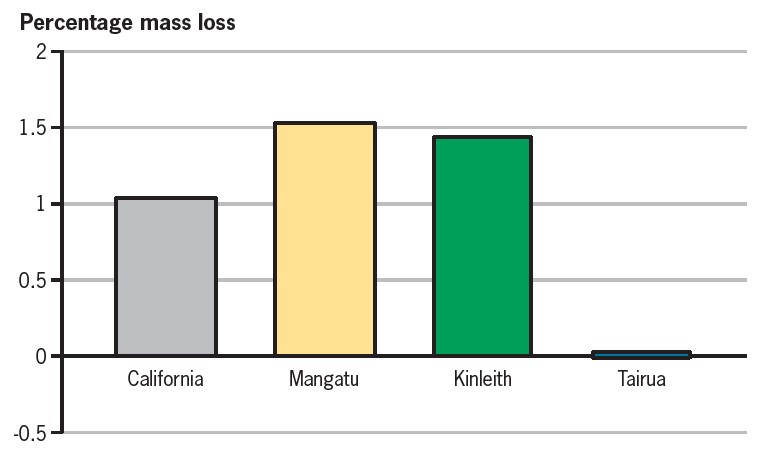
Relationships
The researchers found a strong relationship between the near-infrared spectra and heartwood’s resistance to fungal decay for individual heartwood specimen blocks. They developed a statistical model which could predict how much heartwood mass would be lost for trees aged from 13 to 90 years. They also found that heartwood resistance to fungal decay in the first six metres of the stem is highly correlated to heartwood fungal resistance in the rest of the tree. The near-infrared spectra from heartwood samples taken at 1.4 metres or six metres height could accurately predict the average heartwood mass loss for the entire tree.
Summary and conclusions
This work provides for the first time a systematic analysis of heartwood durability of New Zealand grown coast redwood across different ages, sites, and genetics. The major findings are
- Heartwood durability develops at an early age and appears to reach maturity by 46 years
- There is a strong relationship between near-infrared spectra and heartwood mass loss due to fungal decay, and this relationship was used to develop a statistical model to predict this. A heartwood sample, such as a bark to pith wood core from a live tree, can predict the overall stem natural durability characteristics.
- The genetics of coast redwood has a strong influence on heartwood durability. Seedlings of the same genetic material which is planted over a range of sites with different productivity will probably have similar heartwood durability characteristics at harvest.
- The heartwood from Zealand-grown trees aged 46 to 90 years had similar durability characteristics to heartwood from Californian-grown trees aged between 80 and 100 years.
The near-infrared scanning method can be used as a rapid screening process to identify if the heartwood is either likely to be durable, not durable, or to be highly durable. This can be carried out with heartwood samples taken from live trees or from timber samples. Near-infrared scanning technology could be developed to screen coast redwood timber being sawn for natural durability, and to grade it appropriately for its end use.
Further research is required to obtain heartwood samples from stands at harvest age of 40 to 45 years, to refine the three durability ratings further with more samples, and to provide NZ Standards a statistical link between the durability measured using this method and the traditional environmental exposure durability tests. That said, this study provides evidence that shows New Zealand-grown coast redwood is as durable as redwoods from US second-forests. The study conclusively showed that the influence of genetics on durability is strong and the heartwood durability characteristics from the same genotype will perform similarly across different sites. Finally, the New Zealand redwood sector has a test method which can be used to rapidly screen coast redwood heartwood for durability.
We would like to thank the Sustainable Farming Fund for supporting this project, the NZFFA Sequoia Action Group for being a key research partner and co-funder, and the forestry companies which contributed funding and valuable time.
Dean Meason is a Deputy Research Leader of the Forest Systems team at Scion and has led several studies on coast redwood growth, productivity, silviculture, and timber since 2013.

 Farm Forestry New Zealand
Farm Forestry New Zealand